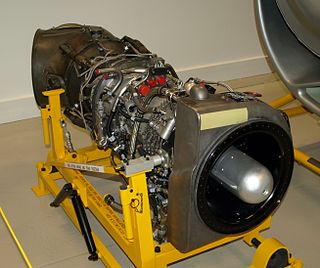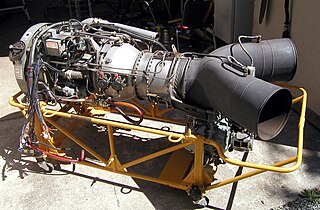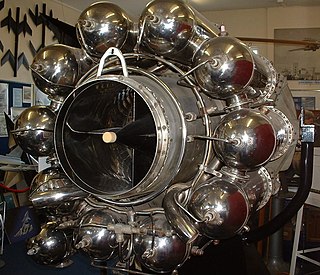
A gas turbine, also called a combustion turbine, is a type of continuous flow internal combustion engine. The main parts common to all gas turbine engines form the power-producing part and are, in the direction of flow:
An air-start system is a power source used to provide the initial rotation to start large diesel and gas turbine engines.

The Bristol Proteus was the Bristol Engine Company's first mass-produced gas turbine engine design, a turboprop that delivered just over 4,000 hp (3,000 kW). The Proteus was a reverse-flow gas turbine. Because the second turbine drove no compressor stages, but only the propeller, this engine was classified as a free-turbine. It powered the Bristol Britannia airliner, small naval patrol craft, hovercraft and electrical generating sets. It was also used to power a land-speed record car, the Bluebird-Proteus CN7. After the merger of Bristol with Armstrong Siddeley the engine became the Bristol Siddeley Proteus, and later the Rolls-Royce Proteus. The Proteus was to have been superseded by the Bristol Orion which would have given a Britannia a 75% increase in power for cruising faster.

The Turbo-Union RB199 is a turbofan jet engine designed and built in the early 1970s by Turbo-Union, a joint venture between Rolls-Royce, MTU and Aeritalia. The only production application was the Panavia Tornado.

The Rolls-Royce Olympus was the world's second two-spool axial-flow turbojet aircraft engine design, first run in May 1950 and preceded only by the Pratt & Whitney J57, first-run in January 1950. It is best known as the powerplant of the Avro Vulcan and later models in the Concorde SST.

The Pratt & Whitney Canada PT6 is a turboprop aircraft engine produced by Pratt & Whitney Canada. Its design was started in 1958, it first ran in February 1960, first flew on 30 May 1961, entered service in 1964 and has been continuously updated since. It consists of two basic sections: a gas generator with accessory gearbox and a free power turbine with reduction gearbox, and is often seemingly mounted backwards in an aircraft in so far as the intake is at the rear and the exhaust at the front. Many variants of the PT6 have been produced, not only as turboprops but also as turboshaft engines for helicopters, land vehicles, hovercraft, and boats; as auxiliary power units; and for industrial uses. By November 2015, 51,000 had been produced, had logged 400 million flight hours from 1963 to 2016. It is known for its reliability with an in-flight shutdown rate of 1 per 651,126 hours in 2016. The PT6A covers the power range between 580 and 1,940 shp while the PT6B/C are turboshaft variants for helicopters.

The Rolls-Royce RB.23 Welland was Britain's first production jet engine. It entered production in 1943 for the Gloster Meteor. The name Welland is taken from the River Welland, in keeping with the Rolls-Royce policy of naming early jet engines after rivers based on the idea of continuous flow, air through the engine and water in a river.

The Rolls-Royce Gnome is a British turboshaft engine originally developed by the de Havilland Engine Company as a licence-built General Electric T58, an American mid-1950s design. The Gnome came to Rolls-Royce after their takeover of Bristol Siddeley in 1968, Bristol having absorbed de Havilland Engines Limited in 1961.

The Bristol Siddeley Nimbus, later known as the Rolls-Royce Nimbus, was a British turboshaft engine developed under license by Blackburn Aircraft Ltd. from the Turbomeca Turmo in the late 1950s. It was used on the Westland Scout and Westland Wasp helicopters.

The Avro Canada TR5 Orenda was the first production jet engine from Avro Canada's Gas Turbine Division. Similar to other early jet engines in design, like the Rolls-Royce Avon or General Electric J47, the Orenda nevertheless outperformed its rivals in most ways, and the Orenda-powered Canadair Sabres were among the fastest of all first-generation jet fighters. Over 4,000 Orendas of various marks were delivered during the 1950s, Avro's greatest engine success.

The Rolls-Royce/Snecma Olympus 593 was an Anglo-French turbojet with reheat (afterburners), which powered the supersonic airliner Concorde. It was initially a joint project between Bristol Siddeley Engines Limited (BSEL) and Snecma, derived from the Bristol Siddeley Olympus 22R engine. Rolls-Royce Limited acquired BSEL in 1966 during development of the engine, making BSEL the Bristol Engine Division of Rolls-Royce.

This article briefly describes the components and systems found in jet engines.

The Napier Oryx was a British gas-turbine engine designed and built by Napier in the early 1950s for the Percival P.74 tip jet-powered helicopter project. The P.74 was unsuccessful and it and the Oryx were cancelled.

The Power Jets W.2 was a British turbojet engine designed by Frank Whittle and Power Jets Ltd. Like the earlier Power Jets W.1, the reverse-flow combustion configuration included a double-sided centrifugal compressor, 10 combustion chambers and an axial-flow turbine with air-cooled disc.

The Solar T62 Titan is an American gas turbine engine used mainly as a helicopter auxiliary power unit (APU), ground power generator, turboprop engine or helicopter turboshaft engine. A free power turbine version was developed as the Solar T66.
The Fiat 4700 was an Italian turbo-generator developed by Fiat Aviazione under contract to the Italian Defence Ministry and used to power the experimental Fiat 7002 tip jet helicopter.
The Turbomeca Orédon was a small French turbo-shaft / Auxiliary Power Unit (APU) engine produced by Turbomeca in the late 1940s.

Many variations of aircraft engine starting have been used since the Wright brothers made their first powered flight in 1903. The methods used have been designed for weight saving, simplicity of operation and reliability. Early piston engines were started by hand, with geared hand starting, electrical and cartridge-operated systems for larger engines being developed between the wars.
The Ivchenko AI-8 is an aircraft auxiliary power unit developed and produced by Ivchenko-Progress and Motor Sich.

The Rolls-Royce Olympus turbojet engine was developed extensively throughout its production run, the many variants can be described as belonging to four main groups.















